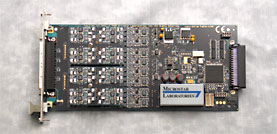
Signal Conditioning/Sensor Interface Products
|
|
|
|
|
|
|
Signal Conditioning
Signal conditioning amplifies, filters, converts, normalizes, and otherwise processes the signal from a sensor so that a data acquisition board can read it. Sensors sometimes require voltage or current excitation, and signal conditioning/sensor interface products from Microstar Laboratories provide this excitation as required, along with processing the signal.
Add these sensor interface products to your DAP-board data acquisition system to add signal conditioning – and other features.
MSXB 067: voltage excitation with filtering for strain gauges and other resistive sensors
MSXB 066: voltage excitation for strain gauges and other resistive sensors
MSXB 065: filtered differential inputs with gain and simultaneous sampling
MSXB 064: differential inputs with gain and simultaneous sampling
MSXB 048: filtered analog inputs
MSXB 028: simultaneous inputs
MSXB 027: analog isolation
For iDSC 1816 anti-aliasing boards, the SCS Signal Conditioning System provides the solution.
MSXB 044: signal conditioning board
SCS: signal conditioning system
A sensor takes its form from its function (what it senses): accelerometer (motion); strain gauge (weight, stress, pressure); thermocouple, thermistor, RTD (temperature); etc. And each sensor generates a characteristic signal, typically a weak one.
Every signal conditioning/sensor interface product from Microstar Laboratories includes for each channel a dedicated instrumentation amplifier: a high input impedance differential op-amp circuit. High input impedance preserves the integrity of the measured signal, so that the measurement does not affect the signal. Low impedance outputs from the instrumentation amplifier match the input requirements of multiplexed high-speed data acquisition boards.
Every signal conditioning/sensor interface product from Microstar Laboratories lets you sample all channels simultaneously if you want to do that because your application requires inter-channel phase measurements for transfer function computations, or because you require simultaneous sampling for applications like multichannel spectral analysis. The sample-and-hold option eliminates phase errors introduced by sequential sampling.
Microstar Laboratories offers most signal conditioning/sensor interface products in two versions: with and without analog anti-alias filters. The anti-alias filters - on attached daughterboards - allow a wide selection of cutoff frequencies. For a sharper cutoff, or for programmable frequency response, follow the analog anti-alias filter with a digital FIRFILTER implemented in DAPL.
If your signal includes unwanted frequencies above half the sampling rate - above the Nyquist frequency - then order the version of the signal conditioning/sensor interface product with analog anti-alias filters. This guarantees that your sampled data will not include alias frequencies that corrupt your results. When you order, choose the cut-off frequency appropriate for your application.
Each different sensor type commonly terminates with a specific connector. You can choose a signal conditioning/sensor interface product with a matching connector, or, for high-channel count applications, you may prefer high-density connectors.
Microstar Laboratories implements signal conditioning/sensor interface products as 3U Eurocard B boards to conform with the channel architecture the company uses.
Microstar Laboratories supports an expanding variety of sensor types. Contact us for more information about the developing product line.
Do you need a specific function added to your DAP system? Browse the function list. Or use the overview table.
Do you know the part number of the signal interface board you need? Browse the part number list.
Do you know the DAP board you use – or will use – and only want to see the signal interface boards that work with it?
